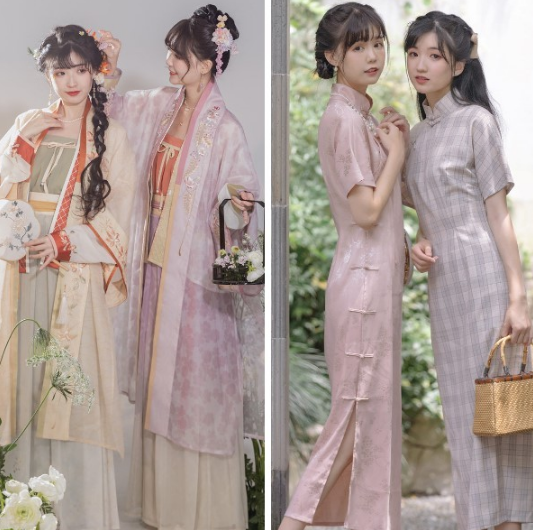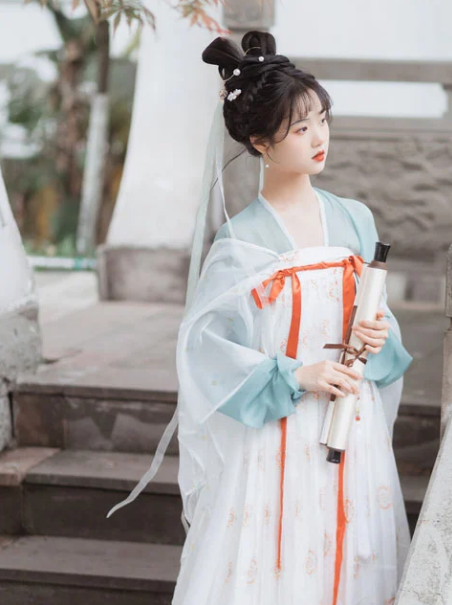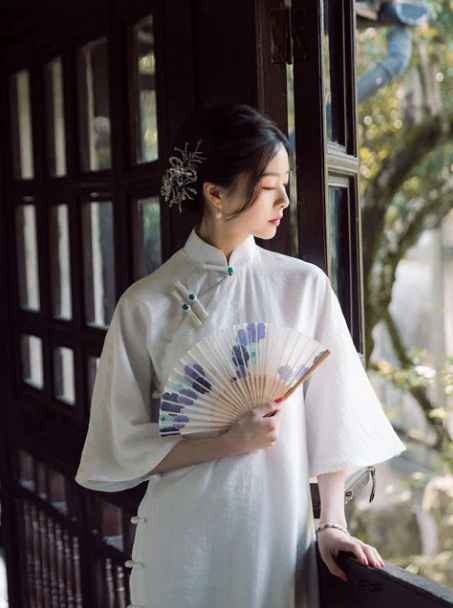Introduction to Traditional Chinese Attire
Traditional Chinese clothing represents a vital aspect of the nation’s culture and history. It not only showcases the aesthetic artistry of Chinese civilization but also reflects the evolving social norms, ethics, and spiritual beliefs through the centuries.
Overview of Ancient Chinese Clothing
Ancient Chinese clothing varied significantly over different dynasties. During the Shang Dynasty, people primarily wore simple tunics and skirts made from animal hides and furs. With the establishment of silk production, as recorded in Silk’s history on Wikipedia, silk garments became popular in the Zhou Dynasty, symbolizing status and wealth. The attire often included long robes, wide sleeves, and was fastened with a sash, indicating a person’s social status. Intricate embroidery and vibrant colors like red, which symbolizes good luck and joy in Chinese culture, were common.

Historical Significance of Attire in Chinese Culture
Chinese attire has deep historical significance, reflecting the philosophical and cultural values of different periods. For instance, Confucian ideals greatly influenced Hanfu design during the Han Dynasty, emphasizing modesty and restraint. Clothing in ancient China also adhered to strict hierarchical guidelines, indicating one’s rank and social position. The color, design, and material of the attire were highly indicative of these distinctions. For example, dragon motifs, exclusively reserved for emperors as seen on Imperial dragon robes, denoted supreme power and authority.
In summary, traditional Chinese attire serves as a rich, visual history of China’s past, encompassing the evolution of fashion, social structure, and cultural practices over thousands of years. It’s not just clothing but a narrative woven with the threads of time and tradition.
Understanding Hanfu
Hanfu, the traditional clothing of the Han Chinese people, is a symbol of Chinese culture and aesthetics. Its history spans over 3000 years, deeply rooted in the Chinese civilization.
Origin and Evolution of Hanfu
Hanfu originated in the Yellow River civilization during the Huangdi and Yandi era, dating back to the Neolithic age. The attire saw major evolution during the Shang and Zhou dynasties, when silk weaving and dyeing technologies advanced, as described in Chinese textile history. Hanfu evolved through various dynasties, each adding unique elements and styles. During the Tang Dynasty, Hanfu became more elaborate and colorful, reflecting the empire’s prosperity. The Ming Dynasty’s version, with its straight collars and wide sleeves, is often what people refer to today when they discuss traditional Hanfu.
Key Characteristics and Variations
Hanfu’s key characteristics include cross-collared robes, wide sleeves, and a sash to fasten the clothing instead of buttons. The typical ensemble consists of a yi (a narrow-cuffed, knee-length tunic tied with a sash), a chang (an ankle-length skirt), and a bixi (a length of fabric that reaches the knees). Variations exist based on gender, season, and social status. Women’s Hanfu often features softer fabrics and more embroidery, seen in the detailed records of women’s Hanfu on Wikipedia. Male attire typically focuses on simpler designs and darker colors. The clothing’s fabric and color also change according to the seasons – lighter materials like silk and brighter colors for summer, heavier fabrics and darker tones for winter.
In essence, Hanfu is not just a form of traditional clothing but an embodiment of the philosophical, moral, and cultural ideals of ancient China. It reflects the harmony between humans and nature, a principle deeply engraved in Chinese thought.
The Emergence of the Cheongsam (Qipao)
The Cheongsam, also known as Qipao, is a famous traditional Chinese dress. It has evolved significantly from its origins to become a symbol of Chinese femininity and fashion.
Historical Background of the Cheongsam
The Cheongsam originated from the Manchu people of China’s Qing Dynasty. Originally a loose-fitting dress, it covered most of the woman’s body, revealing only the head, hands, and the tips of the toes. With the fall of the Qing Dynasty and the rise of the Republic of China, the Cheongsam underwent a dramatic transformation. Influenced by Western fashion and the need for more practical attire, the Cheongsam became more form-fitting, shorter, and stylish, signifying a blend of traditional Chinese culture with modern elements. This transformation reflects a pivotal shift in Chinese social and cultural landscapes, aligning with the women’s liberation movements and rapidly changing societal norms.
Design, Influences, and Cultural Significance
The design of the Cheongsam highlights the beauty of the female form while retaining traditional aesthetic features. It typically has a high neck, snug waist, and slits on one or both sides. The evolution in its design, especially during the Shanghai golden era (1920s and 1930s), as seen in Shanghai’s fashion history, demonstrates the fusion of Eastern and Western fashion sensibilities. Silk, with its delicate embroidery, is the most popular material, showcasing elegance and grace. The Cheongsam has gone beyond being merely a piece of clothing; it represents the emancipation of women, blending a respect for tradition with a nod to modernity and independence. Its influence and significance have spread worldwide, becoming a celebrated element of cultural fashion and identity.
The Cheongsam, in its modern form, remains a popular choice for formal events and a source of inspiration for fashion designers globally, symbolizing a unique blend of tradition, modernity, elegance, and cultural pride.
Comparing Hanfu and Cheongsam
Hanfu and Cheongsam, both traditional Chinese dresses, have distinct styles, fabrics, patterns, and cultural meanings, reflecting different historical periods and societal changes in China.
Differences in Style, Fabric, and Patterns
The Hanfu, traditionally worn by the Han Chinese, typically features a cross-collar, flowing sleeves, and a wide belt, emphasizing elegance and fluidity. Its fabrics range from silk to linen, often decorated with traditional Chinese patterns like dragons, phoenixes, and floral motifs, symbolizing prosperity and good fortune.
In contrast, the Cheongsam, which evolved from the Manchurian Qing Dynasty, is known for its form-fitting shape, high neck, and side slits. It uses materials like silk and brocade but leans towards a simpler, more streamlined design, often featuring bright, solid colors and minimalistic patterns. This design shift signifies a move towards modernity and practicality in Chinese fashion.
Symbolic Meanings and Cultural Contexts
Hanfu carries deep cultural and historical significance, representing China’s traditional Confucian ideals like harmony, modesty, and righteousness. It embodies the spirit of ancient Chinese civilization and its philosophical doctrines. The Hanfu revival movement, gaining momentum, advocates for cultural identity and heritage preservation, reflecting the longing for historical continuity in a rapidly changing society.
The Cheongsam, meanwhile, symbolizes the fusion of traditional Chinese and modern Western aesthetics. It reflects the changing role of Chinese women throughout history, particularly during the early 20th century, when societal attitudes towards women and fashion began to liberalize. The Cheongsam, often seen in international fashion circles, showcases the adaptability and evolving nature of Chinese culture, blending past and present, tradition and modernity.

Both Hanfu and Cheongsam, while different in appearance and connotations, stand as testaments to the rich, diverse tapestry of Chinese history and culture. They continue to influence fashion and convey deep-seated cultural values in their unique ways.
Cultural and Modern Perspectives
The evolving perspectives on traditional and modern attire in contemporary China highlight the dynamic interplay between fashion, culture, and identity. These perspectives shape how Chinese people view their past and present.
Perceptions of Traditional vs. Modern Attire in Contemporary China
In today’s China, traditional attire like Hanfu and Cheongsam coexists with modern fashion trends. Younger generations, in particular, often see traditional clothing as a symbol of cultural pride and heritage. Events such as Hanfu gatherings and traditional festivals have reignited interest in traditional attire, promoting a sense of belonging and cultural renaissance. However, the practicality and global influence of Western fashion ensure that modern attire remains popular for daily wear. This blend reflects a society that respects its past while navigating modern life.
The Role of Fashion in Cultural Identity
Fashion serves as a powerful tool for expressing cultural identity. In China, traditional attire is not just clothing but a medium to showcase national history and philosophy. Design elements in both Hanfu and Cheongsam incorporate significant cultural symbols and motifs, linking wearers to their heritage. The growing popularity of these garments, especially among the youth, signals a renewed interest in exploring and redefining Chinese identity. It also mirrors broader trends seen globally, where fashion becomes a statement of cultural diversity and individuality.
Modern Chinese fashion designers often infuse traditional motifs and styles into contemporary designs, creating outfits that bridge the old and the new. This fusion not only keeps traditional arts alive but also shows the evolving nature of Chinese aesthetics. In the global fashion scene, such designs offer a glimpse into China’s rich cultural tapestry, telling stories of its history, myths, and values.
Conclusion: Cheongsam and Hanfu in the Fabric of Chinese History
The Cheongsam and Hanfu, more than just garments, are integral parts of Chinese history and culture. They offer insights into China’s past and present, embodying the nation’s aesthetic evolution and social changes.
Summarizing the Relationship Between Cheongsam and Hanfu
Cheongsam and Hanfu, while distinct, share a common thread in representing Chinese cultural identity. Hanfu recalls the ancient Chinese civilization and its values, embodying the traditional Confucian ethos and aesthetics. Cheongsam, evolving during a time of major social change, symbolizes modernity, blending Chinese and Western styles. Together, they reflect the diversity and adaptability of Chinese culture through the ages.

The Future of Traditional Chinese Dress in a Globalized World
In a globalized world, traditional Chinese dresses like Hanfu and Cheongsam face both opportunities and challenges. As symbols of Chinese heritage, they have the potential to promote cultural understanding and diversity on the international stage. Fashion designers are creatively incorporating elements of these traditional attires into contemporary designs, making them more relevant and appealing to a global audience.
Yet, the survival and popularity of these traditional forms in the future will depend largely on their ability to adapt to changing tastes and lifestyles while retaining their cultural essence. As ambassadors of Chinese culture, Hanfu and Cheongsam will continue to play a crucial role in introducing and educating the world about the richness and depth of Chinese history and traditions. Their evolution and endurance will symbolize the ongoing narrative of China’s journey through time.







